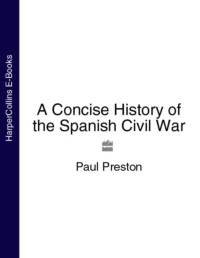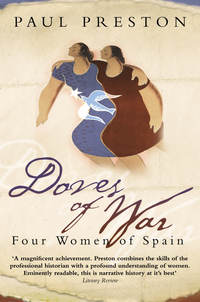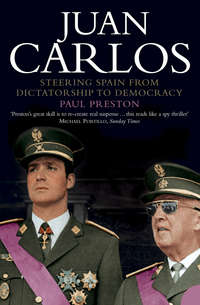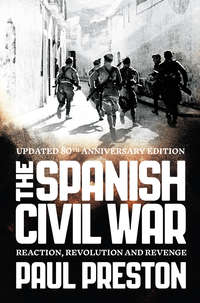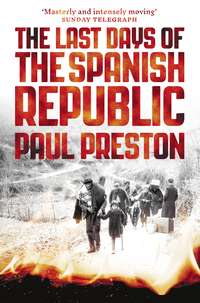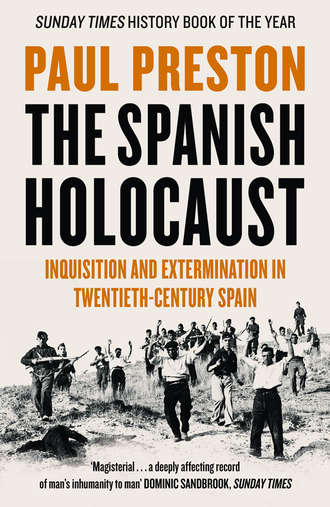
Полная версия
The Spanish Holocaust: Inquisition and Extermination in Twentieth-Century Spain
For the Republican–Socialist cabinet, the subversive activities of the CNT constituted rebellion. For the CNT, legitimate strikes and demonstrations were being crushed by dictatorial methods indistinguishable from those used by the monarchy. On 21 July 1931, the cabinet agreed on the need for ‘an urgent and severe remedy’. Maura outlined a proposal for ‘a legal instrument of repression’ and the Socialist Minister of Labour, Francisco Largo Caballero, proposed a decree to make strikes illegal. The two decrees would eventually be combined on 22 October into the Law for the Defence of the Republic, a measure enthusiastically supported by the Socialist members of the government not least because it was perceived as directed against their CNT rivals.9 It made little difference to the right, which perceived the violent social disorder of the anarchists as characteristic of the entire left, including the Socialists who denounced it and the Republican authorities who crushed it.
What mattered to the right was that the Civil Guard and the army lined up in defence of the existing economic order against the anarchists. Traditionally, the bulk of the army officer corps perceived the prevention of political and economic change as one of its primordial tasks. Now, the Republic would attempt to reform the military, bringing both its costs and its mentalities into line with Spain’s changed circumstances. A central part of that project would be the streamlining of a massively swollen officer corps. The tough and uncompromising colonial officers, the so-called Africanistas, having benefited from irregular and vertiginous battlefield promotions, would be the most affected. Their opposition to Republican reforms would inaugurate a process whereby the violence of Spain’s recent colonial history found a route back into the metropolis. The rigours and horrors of the Moroccan tribal wars between 1909 and 1925 had brutalized them. Morocco had also given them a beleaguered sense that, in their commitment to fighting to defend the colony, they alone were concerned with the fate of the Patria. Long before 1931, this had developed into a deep contempt both for professional politicians and for the pacifist left-wing masses that the Africanistas regarded as obstacles to the successful execution of their patriotic mission.
The repressive role of both the army and the Civil Guard in Spain’s long-standing social conflicts, particularly in rural areas, was perceived as central to that patriotic duty. However, between 1931 and 1936, several linked factors would provide the military with pervasive justifications for the use of violence against the left. The first was the Republic’s attempt to break the power of the Catholic Church. On 13 October 1931, the Minister of War, and later Prime Minister and President, Manuel Azaña, stated that ‘Spain has ceased to be Catholic.’10 Even if this was true, Spain remained a country with many pious and sincere Catholics. Now, the Republic’s anti-clerical legislation would provide an apparent justification for the virulent enmity of those who already had ample motive to see it destroyed. The bilious rhetoric of the Jewish–Masonic–Bolshevik conspiracy was immediately pressed into service. Moreover, the gratuitous nature of some anti-clerical measures would help recruit many ordinary Catholics to the cause of the rich.
The religious issue would nourish a second crucial factor in fostering right-wing violence. This was the immensely successful propagation of theories that left-wingers and liberals were neither really Spanish nor even really human and that, as a threat to the nation’s existence, they should be exterminated. In books that sold by the tens of thousands, in daily newspapers and weekly magazines, the idea was hammered home that the Second Republic was foreign and sinister and must be destroyed. This notion, which found fertile ground in right-wing fear, was based on the contention that the Republic was the product of a conspiracy masterminded by Jews, and carried out by Freemasons through left-wing lackeys. The idea of this powerful international conspiracy – or contubernio (filthy cohabitation), one of Franco’s favourite words – justified any means necessary for what was presented as national survival. The intellectuals and priests who developed such ideas were able to connect with the latifundistas’ hatred for the landless day-labourers or jornaleros and the urban bourgeoisie’s fear of the unemployed. The Salamanca landowner Gonzalo de Aguilera y Munro, like many army officers and priests, was a voracious reader of such literature.11
Another factor which fomented violence was the reaction of the landowners to the Second Republic’s various attempts at agrarian reform. In the province of Salamanca, the leaders of the local Bloque Agrario, the landowners’ party, Ernesto Castaño and José Lamamié de Clairac, incited their members not to pay taxes nor to plant crops. Such intransigence radicalized the landless labourers.12 Across the areas of great estates (latifundios) in southern Spain, Republican legislation governing labour issues in the countryside was systematically flouted. Despite the decree of 7 May 1931 of obligatory cultivation, unionized labour was ‘locked out’ either by land being left uncultivated or by simply being refused work and told to comed República (literally ‘eat the Republic’, which was a way of saying ‘let the Republic feed you’). Despite the decree of 1 July 1931 imposing the eight-hour day in agriculture, sixteen-hour working days from sun-up to sun-down prevailed with no extra hours being paid. Indeed, starvation wages were paid to those who were hired. Although there were tens of thousands of unemployed landless labourers in the south, landowners proclaimed that unemployment was an invention of the Republic.13 In Jaén, the gathering of acorns, normally kept for pigs, or of windfall olives, the watering of beasts and even the gathering of firewood were denounced as ‘collective kleptomania’.14 Hungry peasants caught doing such things were savagely beaten by the Civil Guard or by armed estate guards.15
Their expectations raised by the coming of the new regime, the day-labourers were no longer as supine and fatalistic as had often been the case. As their hopes were frustrated by the obstructive tactics of the latifundistas, the desperation of the jornaleros could be controlled only by an intensification of the violence of the Civil Guard. The ordinary Civil Guards themselves often resorted to their firearms in panic, fearful of being outnumbered by angry mobs of labourers. Incidents of the theft of crops and game were reported with outrage by the right-wing press. Firearms were used against workers, and their deaths were reported with equal indignation in the left-wing press. In Corral de Almaguer (Toledo), starving jornaleros tried to break a local lock-out by invading estates and starting to work them. The Civil Guard intervened on behalf of the owners, killing five workers and wounding another seven. On 27 September 1931, for instance, in Palacios Rubios near Peñaranda de Bracamonte in the province of Salamanca, the Civil Guard opened fire on a group of men, women and children celebrating the successful end to a strike. The Civil Guard began to shoot when the villagers started to dance in front of the parish priest’s house. Two workers were killed immediately and two more died shortly afterwards.16 Immense bitterness was provoked by the case. In July 1933, on behalf of the Salamanca branch of the UGT landworkers’ federation (Federación Nacional de Trabajadores de la Tierra), the editor of its newspaper Tierra y Trabajo, José Andrés y Mansó, brought a private prosecution against a Civil Guard corporal, Francisco Jiménez Cuesta, on four counts of homicide and another three of wounding. Jiménez Cuesta was successfully defended by the leader of the authoritarian Catholic party, the CEDA, José María Gil Robles. Andrés y Mansó would be murdered by Falangists at the end of July 1936.17
In Salamanca and elsewhere, there were regular acts of violence perpetrated against trade union members and landowners – a seventy-year-old beaten to death by the rifle butts of the Civil Guard in Burgos, a property-owner badly hurt in Villanueva de Córdoba. Very often these incidents, which were not confined to the south but also proliferated in the three provinces of Aragon, began with invasions of estates. Groups of landless labourers would go to a landowner and ask for work or sometimes carry out agricultural tasks and then threateningly demand payment. More often than not, they would be driven off by the Civil Guard or by gunmen employed by the owners.18
In fact, what the landowners were doing was merely one element of unequivocal right-wing hostility to the new regime. They occupied the front line of defence against the reforming ambitions of the Republic. There were equally vehement responses to the religious and military legislation of the new regime. Indeed, all three issues were often linked, with many army officers emanating from Catholic landholding families. All these elements found a political voice in several newly emerged political groups. Most extreme among them, and openly committed to the earliest possible destruction of the Republic, were two monarchist organizations, the Carlist Comunión Tradicionalista and Acción Española, founded by supporters of the recently departed King Alfonso XIII as a ‘school of modern counter-revolutionary thought’. Within hours of the Republic being declared, monarchist plotters had begun collecting money to create a journal to propagate the legitimacy of a rising against the Republic, to inject a spirit of rebellion in the army and to found a party of ostensible legality as a front for meetings, fund-raising and conspiracy against the Republic. The journal Acción Española would also peddle the idea of the sinister alliance of Jews, Freemasons and leftists. Within a month, its founders had collected substantial funds for the projected uprising. Their first effort would be the military coup of 10 August 1932. And its failure would lead to a determination to ensure that the next attempt would be better financed and entirely successful.19
Somewhat more moderate was the legalist Acción Nacional, later renamed Acción Popular, which was prepared to try to defend right-wing interests within Republican legality. Extremists or ‘catastrophists’ and ‘moderates’ shared many of the same ideas. However, after the failed military coup of August 1932, they would split over the efficacy of armed conspiracy against the Republic. Acción Española formed its own political party, Renovación Española, and Acción Popular did the same, gathering a number of like-minded groups into the Confederación Española de Derechas Autónomas.20 Within a year, the ranks of the ‘catastrophists’ had been swelled by the creation of various fascist organizations. What all had in common was that they completely denied the democratic legitimacy of the Republic. Despite the legalist façade of Acción Popular and the CEDA, its leaders would frequently and unrestrainedly proclaim that violence against the Republic was perfectly justifiable.
Barely three weeks after the establishment of the new regime, at a time when the government was notable mainly for its timidity in social questions, Acción Nacional had been created as ‘an organization for social defence’. It was the creation of Ángel Herrera Oria, editor of the militantly Catholic (and hitherto monarchist) daily El Debate. A shrewd political strategist, Herrera Oria would be the brains behind political Catholicism in the early years of the Second Republic. Acción Nacional brought together two organizations of the right that had combated the rising power of the urban and rural working class for the previous twenty years. Its leaders came from the Asociación Católica Nacional de Propagandistas, an elite Jesuit-influenced organization of about five hundred prominent and talented Catholic rightists with influence in the press, the judiciary and the professions. Its rank-and-file support would be found within the Confederación Nacional Católico-Agraria, a mass political organization which proclaimed its ‘total submission to the ecclesiastic authorities’. Established to resist the growth of left-wing organizations, the CNCA was strong among the Catholic smallholding peasantry in north and central Spain.21
Acción Nacional’s manifesto declared that ‘the advance guards of Soviet Communism’ were already clambering on the ruins of the monarchy. It denounced the respectable bourgeois politicians of the Second Republic as weak and incapable of controlling the masses. ‘They are the masses that deny God and, in consequence, the basic principles of Christian morality; that proclaim, against the sanctity of the family, the instability of free love; that substitute private property, the basis and the motor of the welfare of individuals and of collective wealth, by a universal proletariat at the orders of the State.’ In addition, there was ‘the lunacy of Basque and Catalan ultra-nationalism, determined, irrespective of its sweet words, to destroy national unity’. Acción Nacional unequivocally announced itself as the negation of everything for which, it claimed, the Republic stood. With the battle cry ‘Religion, Fatherland, Family, Order, Work, Property’, it declared that ‘the social battle is being waged in our time to decide the triumph or extermination of these eternal principles. In truth, this will not be decided in a single combat; what is being unleashed in Spain is a war, and it will be a long one.’22
By 1933, when Acción Popular had developed into the CEDA, its analysis of the Republic was even less circumspect: ‘the rabble, always irresponsible because of their lack of values, took over the strongholds of government’. Even for Herrera Oria’s legalist organization, the Republic was created when ‘the contagious madness of the most inflamed extremists sparked a fire in the inflammable material of the heartless, the perverted, the rebellious, the insane’. The supporters of the Republic were sub-human and, like pestilent vermin, should be eliminated: ‘The sewers opened their sluice gates and the dregs of society inundated the streets and squares, convulsing and shuddering like epileptics.’23 All over Europe, endangered elites were mobilizing mass support by stirring up fears of a left presented as ‘foreign’, a disease that threatened the nation and required a crusade of national purification.
Both at the time and later, the right-wing determination to annihilate the Republic was justified as a response to its anti-clericalism. However, as had been amply demonstrated by its enthusiastic support for the dictatorship of Primo de Rivera, the right hated the Republic for being democratic long before it was able to denounce it for being anti-clerical. Moreover, those who opposed the Republic on religious grounds also cited social, economic and political grounds, especially in opposition to regional autonomy.24
Nevertheless, the religious issue was the occasion of intense conflict, both verbal and physical. On Sunday 10 May 1931, the inaugural meeting of the Circulo Monarquico Independiente in the Calle Alcalá ended with loudspeakers provocatively blaring out the Royal Anthem. Republican crowds returning from an afternoon concert in Madrid’s Parque del Buen Retiro were outraged. There was a riot; cars were burned and the offices of the monarchist newspaper ABC in neighbouring Calle Serrano were assaulted. The fierce popular reaction spilled over into the notorious church burnings which took place in Madrid, Málaga, Seville, Cádiz and Alicante from 10 to 12 May. This suggested how strongly ordinary people identified the Church with the monarchy and right-wing politics. The Republican press claimed that the fires were the work of provocateurs drawn from the scab union, the Sindicatos Libres. Indeed, it was claimed that, to discredit the new regime, young monarchists had distributed leaflets inciting the masses to attack religious buildings.25
Even if there were agents provocateurs involved, many on the left were convinced that the Church was integral to reactionary politics in Spain and physical attacks were carried out in some places by the more hotheaded among them. In many villages in the south, priests had stones thrown at them. For those on the right, the identity of the true culprits mattered little. The church burnings confirmed and justified their prior hostility to the Republic. Nevertheless, Miguel Maura, the Minister of the Interior, commented bitterly: ‘Madrid’s Catholics did not think for a second that it was appropriate or their duty to make an appearance in the street in defence of what should have been sacred to them.’ There were serious clashes in many small towns (pueblos) where the faithful protected their churches from elements intent on profaning them. Later in May, when the provisional government decreed an end to obligatory religious education, there were many petitions in protest.26
While most of Spain remained peaceful, from the earliest days of the Republic an atmosphere of undeclared civil war festered in the latifundio zones of the south and in other areas dominated by the CNT. Miguel Maura claimed that, in the five months from mid-May 1931 until his resignation in October, he had to deal with 508 revolutionary strikes. The CNT accused him of causing 108 deaths with his repressive measures.27 This was demonstrated most graphically by the bloody conclusion to a period of anarchist agitation in Seville. As the culmination of a series of revolutionary strikes, the anarchist union called a general stoppage on 18 July 1931. This was directed not just at the local employers but also at the CNT’s local rivals in the Socialist Unión General Trabajadores. There were violent clashes between anarchist and Communist strikers on the one hand and blacklegs and the Civil Guard on the other. At the cabinet meeting of 21 July, the Socialist Minister of Labour, Francisco Largo Caballero, demanded that Miguel Maura take firm action to end the disorders which were damaging the Republic’s image. When the Prime Minister, Niceto Alcalá Zamora, asked if everyone was agreed that energetic measures against the CNT were called for, the cabinet assented unanimously. Maura told Azaña that he would order artillery to demolish a house from which anarchists had fired against the forces of order.28
Meanwhile, on the night of 22–23 July 1931, extreme rightists were permitted to take part in the repression of the strikes in Seville. Believing that the forces of order were inadequate to deal with the problem, José Bastos Ansart, the Civil Governor, invited the landowners’ clubs, the Círculo de Labradores and the Unión Comercial, to form a paramilitary group to be known as the ‘Guardia Cívica’. This invitation was eagerly accepted by the most prominent rightists of the city, Javier Parladé Ybarra, Pedro Parias González, a retired lieutenant colonel of the cavalry and a substantial landowner, and José García Carranza, a famous bullfighter who fought as ‘Pepe el Algabeño’. Arms were collected, and the Guardia Cívica was led by a brutal Africanista, Captain Manuel Díaz Criado, known as ‘Criadillas’ (Bull’s Balls). On the night of 22 July, in the Parque de María Luisa, they shot four prisoners. On the following afternoon, the Casa Cornelio, a workers’ café in the neighbourhood of La Macarena, was, as Maura had promised Azaña, destroyed by artillery fire. Elsewhere in the province, particularly in three small towns to the south of the capital, Coria del Río, Utrera and Dos Hermanas, strikes were repressed with exceptional violence by the Civil Guard. In Dos Hermanas, after some stones had been thrown at the telephone exchange, a lorryload of Civil Guards arrived from Seville. With the local market in full swing, they opened fire, wounding several, two of whom died later. In total, seventeen people were killed in clashes in the province.29
Azaña’s immediate reaction was that the events in the park ‘looked like the use of the ley de fugas’ (the pretence that prisoners were shot while trying to escape) and he blamed Maura, commenting that ‘he shoots first and then he aims’. Azaña’s reaction was influenced by the fact that Maura had recently hit him for accusing him of revealing cabinet secrets to the press. Two weeks later, he learned that the cold-blooded application of the ley de fugas was nothing to do with Maura but had been carried out by the Guardia Cívica on the orders of Díaz Criado.30 The murders in the Parque de María Luisa and the shelling of the Casa Cornelio were the first in a chain of events leading to the savagery of 1936. Díaz Criado and the Guardia Cívica would play a prominent role both in the failed military coup of August 1932 and in the events of 1936.
The events in Seville and the telephone strike were symptomatic of clashes between the forces of order and the CNT throughout urban Spain. In Barcelona, in addition to the telephone conflict, a strike in the metallurgical industry saw 40,000 workers down tools in August. The activist FAI increasingly advocated insurrection to replace the bourgeois Republic with libertarian communism. Paramilitary street action directed against the police and the Civil Guard was to be at the heart of what the prominent FAI leader Juan García Oliver defined as ‘revolutionary gymnastics’. This inevitably led to bloody clashes with the forces of order and with the more moderate Socialist UGT. The consequent violence in Barcelona, Seville, Valencia, Zaragoza and Madrid, although directed against the government, was blamed by the right on the Republic.31
The unease thereby fomented among the middle classes was consolidated among Catholics by the anti-clericalism of the Republic. Little distinction was made between the ferocious iconoclasm of the anarchists and the Republican–Socialist coalition’s ambition to limit the Church’s influence to the strictly religious sphere. Right-wing hostility to the Republic was mobilized fully, with clerical support, in the wake of the parliamentary debate over the proposed Republican Constitution. The text separated Church and state and introduced civil marriage and divorce. It curtailed state support for the clergy and ended, on paper at least, the religious monopoly of education. The proposed reforms were denounced by the Catholic press and from pulpits as a Godless, tyrannical and atheistic attempt to destroy the family.32 The reaction of a priest from Castellón de la Plana was not uncommon. In a sermon he told his parishioners, ‘Republicans should be spat on and never spoken to. We should be prepared to fight a civil war before we tolerate the separation of Church and State. Non-religious schools do not educate men, they create savages.’33
The Republic’s anti-clerical legislation was at best incautious and at worst irresponsible, perceived on the right as the fruit of Masonic-inspired hatred. Republicans felt that to create an egalitarian society, the power of the Church education system had to be replaced with nondenominational schools. Many measures were easily sidestepped. Schools run by religious personnel continued as before – the names of schools were changed, clerics adopted lay dress. Many such schools, especially those of the Jesuits, tended to be accessible only to the children of the rich. There was no middle ground. The Church’s defence of property and its indifference to social hardship inevitably aligned it with the extreme right.34
Substantial popular hostility to the Republic’s plans for changes in the social, economic and religious landscape was garnered during the so-called revisionist campaign against the Constitution. Bitter right-wing opposition to the Constitution passed on 13 October was provoked by plans to advance regional autonomy for Catalonia and to introduce agrarian reform.35 Nevertheless, it was the legalization of divorce and the dissolution of religious orders – seen as evil Masonic machinations – that raised Catholic ire.36 During the debate on 13 October 1931, the parliamentary leader of Acción Popular, José María Gil Robles, declared to the Republican–Socialist majority in the parliament, the Cortes, ‘Today, in opposition to the Constitution, Catholic Spain takes its stand. You will bear responsibility for the spiritual war that is going to be unleashed in Spain.’ Five days later, in the Plaza de Toros de Ledesma, Gil Robles called for a crusade against the Republic.37
As part of the campaign a group of Basque Traditionalists created the Association of Relatives and Friends of Religious Personnel. The Association attracted considerable support in Salamanca and Valladolid, towns notable for the ferocity of the repression during the Civil War. It published an anti-Republican bulletin, Defensa, and many anti-Republican pamphlets. It also founded the violently anti-Masonic and anti-Semitic weekly magazine Los Hijos del Pueblo under the editorship of Francisco de Luis, who would eventually run El Debate in succession to Ángel Herrera Oria. De Luis was a fervent advocate of the theory that the Spanish Republic was the plaything of an international Jewish–Masonic–Bolshevik conspiracy.38 Another leading contributor to Los Hijos del Pueblo was the integrist Jesuit Father Enrique Herrera Oria, brother of Ángel. The paper’s wide circulation was in large part a reflection of the popularity of its vicious satirical cartoons attacking prominent Republican politicians. Presenting them as Jews and Freemasons, and thus part of the international conspiracy against Catholic Spain, it popularized among its readers the notion that this filthy foreign plot had to be destroyed.39


